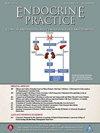电子鼻辅助肾上腺病变生化评估的可行性。
IF 4.6
3区 医学
Q2 ENDOCRINOLOGY & METABOLISM
引用次数: 0
摘要
目的:呼气中挥发性有机化合物(VOCs)的分析已成为一种有前途的非侵入性诊断工具。本研究的目的是评估电子鼻鉴别功能性肾上腺病变-嗜铬细胞瘤(PHEO),原发性醛固酮增多症(PHA)和高皮质醇症(CS) -和非功能性肾上腺病变的潜力。方法:在荷兰的两家三级医院进行了一项试点研究。在2021年5月至2024年6月期间,患有PHEO、PHA、CS和非功能性肾上腺病变的患者使用电子鼻进行呼吸测试。每个中心使用一个不同的电子鼻(设备a和b)。在t-SNE图中评估设备之间数据的可比性,并训练人工神经网络对呼吸模式进行分类。结果:从两个电子鼻获得的数据过于异质,无法汇集,设备B的样本量不足,无法进一步分析。因此,我们分析了76个功能性病变(27个PHEO, 33个PHA, 16个CS)和29个非功能性肾上腺病变的VOC模式。在训练数据中观察到中度判别性能:合并功能病变(曲线下面积(AUC) 0.76), PHEO (AUC 0.76), PHA (AUC 0.72)和CS (AUC 0.58)与非功能病变。然而,当将训练数据开发的模型应用于测试数据时,模型性能显著下降,所有比较的置信区间都很宽。结论:虽然在功能性和非功能性肾上腺病变中检测到VOC模式的轻微差异,但电子鼻在临床实践中的鉴别价值有限。本文章由计算机程序翻译,如有差异,请以英文原文为准。
Feasibility of an Electronic Nose to Aid Biochemical Assessment of Adrenal Lesions
Objectives
Analysis of volatile organic compounds (VOCs) in exhaled breath has emerged as a promising noninvasive diagnostic tool for various diseases. The aim of this study was to evaluate the potential of an electronic nose to differentiate between functional adrenal lesions - pheochromocytoma (PHEO), primary hyperaldosteronism (PHA), and hypercortisolism (CS) - and nonfunctional adrenal lesions.
Methods
A pilot study was conducted at 2 tertiary hospitals within the Netherlands. Patients with PHEO, PHA, CS, and nonfunctional adrenal lesions underwent breath testing with an electronic nose between May 2021 and June 2024. Each center employed a distinct electronic nose (device A and B). Comparability of data between the devices was assessed in a t-distributed stochastic neighbor embedding plot, and an artificial neural network was trained to classify breath patterns.
Results
Data obtained from the 2 electronic noses were too heterogeneous for pooling and device B had an insufficient sample size for further analysis. Therefore, VOC patterns of 76 functional lesions (27 PHEO, 33 PHA, 16 CS) and 29 nonfunctional adrenal lesions measured exclusively with device A were analyzed. Moderate discriminative performance was observed in the training data: pooled functional lesions (area under the curve [AUC] 0.76), PHEO [AUC 0.76], PHA [AUC 0.72] and CS [AUC 0.58] versus nonfunctional lesions. However, model performance declined significantly when applying the model developed with training data on test data, with wide confidence intervals across all comparisons.
Conclusions
While slight differences in VOC patterns were detected between functional and nonfunctional adrenal lesions, the electronic nose demonstrated limited discriminative value for clinical practice.
求助全文
通过发布文献求助,成功后即可免费获取论文全文。
去求助
来源期刊

Endocrine Practice
ENDOCRINOLOGY & METABOLISM-
CiteScore
7.60
自引率
2.40%
发文量
546
审稿时长
41 days
期刊介绍:
Endocrine Practice (ISSN: 1530-891X), a peer-reviewed journal published twelve times a year, is the official journal of the American Association of Clinical Endocrinologists (AACE). The primary mission of Endocrine Practice is to enhance the health care of patients with endocrine diseases through continuing education of practicing endocrinologists.
 求助内容:
求助内容: 应助结果提醒方式:
应助结果提醒方式:


